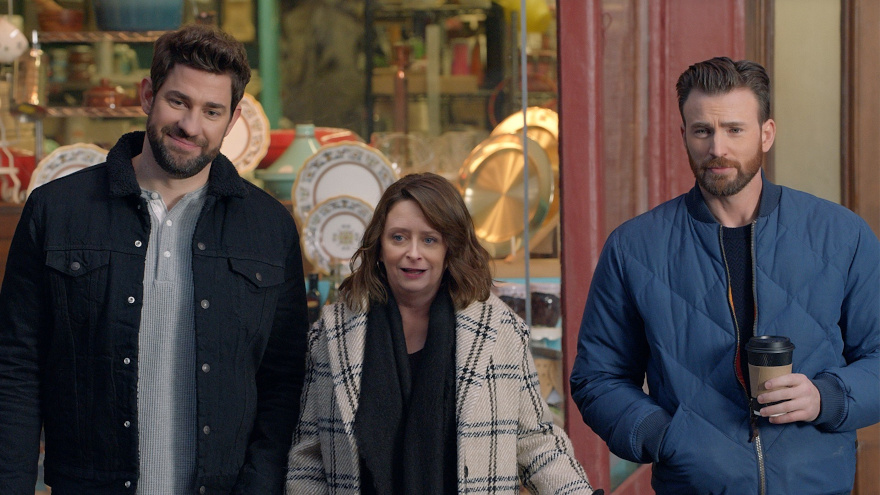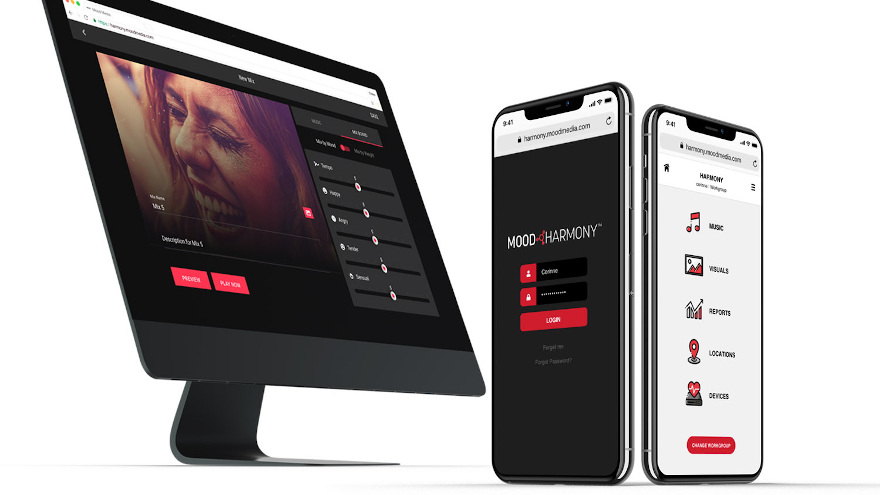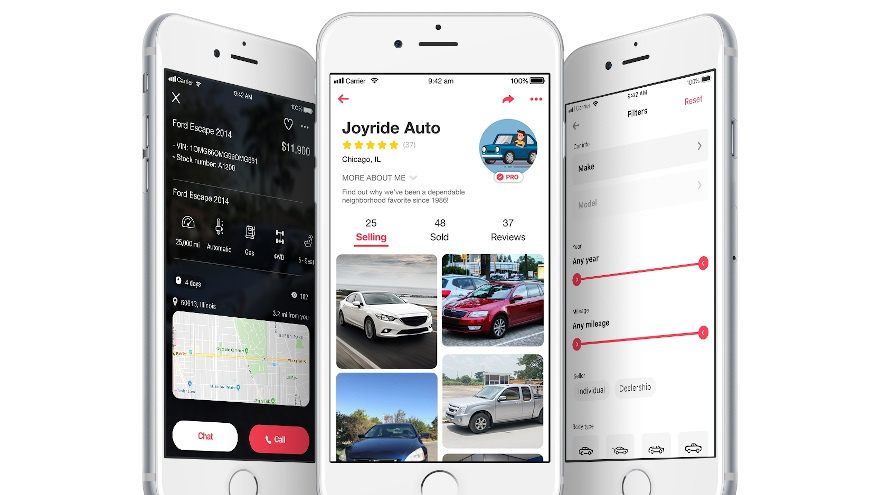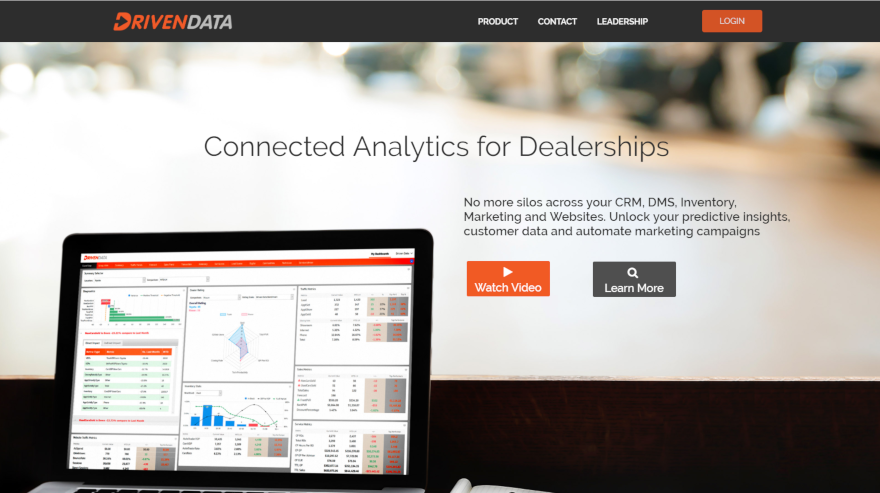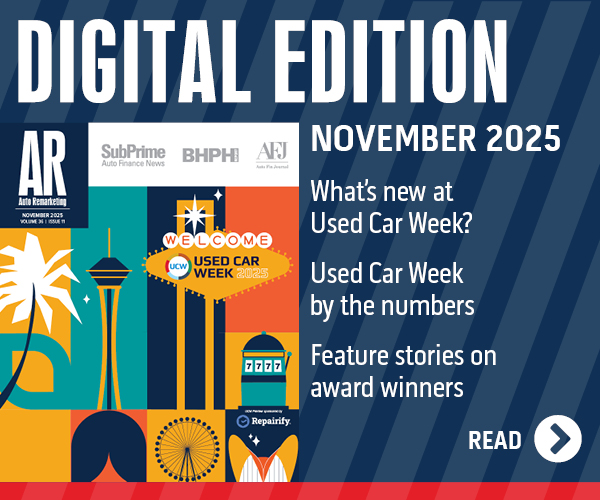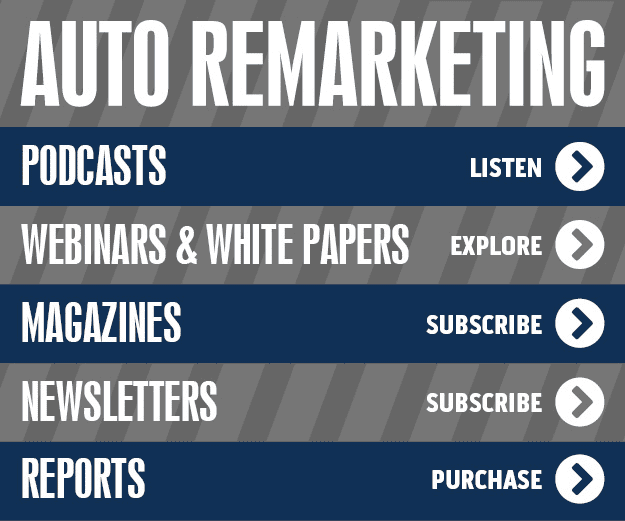AET Media describes its services as providing an advertising asset design and generation capability “that allows for at-scale delivery of unique, visually appealing advertisements.”
Wizely says that with its co-op reporting and pre-approval automation platform, advertisements can get OEM approval and reimbursement at scale. The company offers an advertising audience creation product that it says uses dealership DMS data to generate audiences.
On Friday, the two companies announced a collaboration in creating a product to provide their joint auto industry customers appealing and original equipment manufacturer-compliant digital advertisements.
The companies say auto industry OEM-compliant advertising can be difficult to navigate because of continually changing “regulations and monthly program changes.”
“Together, this collaboration delivers a scalable platform that simplifies and automates the delivery of OEM-compliant advertising across the automotive industry,” the companies wrote in a news release.
The companies describe the combined AET and Wizely product offering as “the easy-button for OEM-compliant automotive advertising.” They say it reduces the time from idea to launch from weeks to hours, and it does that by automating all of the elements of creating OEM-compliant campaigns.
AET Media says it allows customers to create visually attractive advertisements with OEM compliant “advertising creative,” disclaimers and campaigns built into the platform.
The company says that with the ad creative tool, it is no longer necessary to be a graphic designer to create eye-catching ads.
Users have access to audience targeting and messaging that the company says is customizable to their needs. After the ad is designed and targeting is established, the user can upload it directly to the company’s social media account or accounts.
The company says that makes its platform a single tool for ad creative, ad copy, audience targeting and deployment.
Wizely says its products pair well with the AET platform. Its Co-op Accelerator automates the creation of OEM-compliant co-op reporting, according to Wizely, and the company says that with the Accelerator, clients can track co-op budgets compared to spend, allowing for close management of co-op spending.
The company says that with its Wizely Pinpoint product, clients can use their own first-party data to target consumers with timely advertising.
“I’m really excited about this partnership.” Wizely founder James Grace said in a news release.
He continued, “Every month our industry faces the challenge of quickly building attractive and OEM compliant visual advertisements, targeting them to the right customers and getting co-op approval and reimbursement. The combined AET and Wizely platform solves this problem with an unprecedented level of speed and scalability that we think will be attractive both to dealerships and agencies.”
The companies say that through this partnership, joint customers can count on competitive pricing and operational alignment.
That, they say, ensures cohesive management of the campaigns from concept through pre-approval, design, and co-op reimbursement.
Entertaining commercials are always a highlight of Super Bowl television broadcasts, and during the first quarter of the upcoming big game on Feb. 2 in Miami, an ad for the all-new 2020 Hyundai Sonata will continue that tradition.
The ad will begin with comedian Rachel Dratch serving as Boston Red Sox legend David Ortiz's dialect coach, helping to refine his Boston accent.
Hyundai's Super Bowl commercial will mark the beginning of the national advertising campaign for the 2020 Sonata. Hyundai describes the Sonata as its longest-standing and most successful model.
The automaker says the all-new version of the Sonata offers a “bold, distinctive design and numerous convenient and safety technologies.”
“It is a fully transformed vehicle that showcases a sporty four-door-coupe look and represents Hyundai's new focus on creating an emotional appeal using proportion, styling and technology,” Hyundai said in a news release.
In Hyundai’s Super Bowl commercial for the vehicle, which will air on FOX, Chris Evans and John Krasinski also headline the cast. Evans, who stars in commercial and independent films and an upcoming Apple+ show that he produced, is making his first appearance in a Super Bowl commercial.
Krasinski has written, starred in and directed numerous TV shows and movies. Dratch was an SNL cast member and guest star on several popular TV shows.
Ortiz, nicknamed “Big Papi,” was a three-time World Series champion and a 10-time All-Star.
The final ad will make its world premiere during the Super Bowl Greatest Commercials 2020 special on the CBS Television Network on Jan. 27, from 9 to 10 p.m. ET/PT. It will also include a behind-the-scenes segment on the making of the spot.
"Casting is such a critically important part of the ad, and we found four celebrities who worked perfectly together and made our creative concept come to life brilliantly," said Hyundai Motor America chief marketing officer Angela Zepeda.
She continued, “Combine that talent with our director Bryan Buckley and the team at our ad agency INNOCEAN, and we think we have another winner on our hands. We just finished testing the spot and it performed exceptionally well. We can’t wait to release it on CBS’ primetime special and show everyone a little bit of what went into the making of the spot.”
Bryan Buckley has directed more than 60 Super Bowl commercials and has received the Directors Guild of America award, multiple Emmys, and more than 50 Cannes Lions. Creativity Magazine also named him one of the 50 Best Creative Minds in the last 25 years.
His production company, Hungry Man, produced the spot.
INNOCEAN USA’s executive creative director Barney Goldberg said good commercials start with a strong script.
“And we went through hundreds to get to this one,” he said.
He continued, “Obviously, humor is always a great way to disarm the viewer and grab their attention. This particular idea focuses on the iconic Boston accent. It was important to us to make sure everything was authentic. Shooting in Boston instead of a backlot and casting Boston icons really paid off for us in this spot. We even threw in a few local ‘Easter eggs’ for anyone paying close attention. I think we really captured the feel of the city as well as highlighting a great feature on the new Sonata."
Hyundai said the latest Sonata is the first model to be based on Hyundai's new vehicle platform, which it says brings improvements in overall driving performance.
According to the automaker, the car’s use of an application of advanced technologies boosts comfort, convenience and active safety.
Features include a new Digital Key, which the company says allows the vehicle to be unlocked, started and driven without a physical key.
Gayle Rogers, chief marketing officer and director of digital marketing at Strong Automotive Merchandising, joins the Auto Remarketing Podcast.
In this episode, he talks with senior editor Joe Overby about how digitization has impacted automotive advertising, the benefits of call tracking, YouTube usage among car dealers and more.
To listen to this episode, click on the link available below.
Download and subscribe to the Auto Remarketing Podcast on iTunes or on Google Play.
Greta Crowley says sports have been a “huge component” of Autotrader’s marketing plan for years.
“It's something where we’re constantly looking at research and the data, and what we're continuing to see is that sports fans are so incredibly passionate and are brand-loyal for those brands that invest in our long-term partners and sponsors,” said Crowley, who is Autotrader vice president of marketing, in an interview with Auto Remarketing.
The NBA is a major part of that huge sports component that Crowley mentioned, and Autotrader’s 16th season as an NBA partner premiered Tuesday night with a Tip-Off Show presented by Autotrader, followed by a doubleheader.
Crowley said Autotrader’s partnership with the NBA helps the company reach a young and diverse audience. That, she said, is much more difficult to achieve through purchasing “one-off” TV spots.
“This really encompasses a full marketing plan where we can touch consumers literally in stadium, with courtside signage all the way to promotions to TV spots running in all the biggest games,” Crowley said.
Starting its 16th season as a partner of the NBA, Autotrader gets various opportunities for attention as “the Official Car Search Engine of the NBA.”
In addition to the pre-game, in-game and digital streaming presence, Autotrader for the 14th year will support the donation of a vehicle to a recipient via the All-Star Drive Charity Giveaway during NBA All-Star weekend.
Autotrader is the exclusive partner of the NBA on TNT Tip-Off Show presented by Autotrader, and at least 34 of those pre-game shows are on the schedule throughout this season with analysts Charles Barkley, Shaquille O’Neal, Kenny Smith and host Ernie Johnson.
Autotrader’s additional in-game exposure, reaching millions of fans each week, will take place through the regular season and playoff game broadcasts on TNT and NBA TV, as well as online via NBA.com.
Crowley told Auto Remarketing that throughout its 16 years of sponsorship of the program, Autotrader has seen increases in traffic on its website after its TV spots air during the games.
“And we're driving a ton of brand awareness for Autotrader,” she said. “We continue to see that back on our site.”
This year, she said, Autotrader is focusing on its new Finally, it’s easy consumer campaign.
“So we are really trying to partner with NBA this year to figure out how do we bring that idea of stress-free shopping with Autotrader through into the new promotion,” she said. “We’re getting ready, obviously, to kick off the NBA season this week.
“But we've got some new things on promotion this year and how we think about our (All-Star Drive Charity Giveaway), where we give back to the community during All-Star weekend and how we can wrap our new campaign around that.”
For dealers who want to revamp or streamline their branding, Mood Media has what it believes is a complete solution.
The in-store media solutions company dedicated to elevating the customer experience on Wednesday unveiled Harmony, its new all-in-one multimedia brand experience platform. This proprietary technology platform can enable brands to connect and manage all of their in-store content — including music, messaging, visuals and interactive components — through one singular content management system (CMS).
With Harmony, brands are now able to control and run all of their in-store experiences off of one digital dashboard, ensuring all media elements are running in harmony with one another.
Mood Harmony said it can allow brands to shift away from using different devices and platforms, instead providing one cohesive system that simplifies and streamlines their ability to create and execute the entire in-store experience.
“Our new Harmony platform alleviates major pain points that many retailers and other consumer-facing businesses deal with due to having to use multiple vendors and systems,” Mood Media chief executive officer David Hoodis said in a news release.
“With our new end-to-end offering, brands gain the unprecedented ability to manage all of their tech-powered in-store experiences in one place, via an easy-to-use dashboard,” Hoodis continued.
Additionally, Mood Media is introducing the Harmony A/V Media Player, one of the newest offerings available within Mood’s Harmony platform. This new compact multimedia device can give brands the ability to play and support robust HD content from a single player — including music, HD video, HTML5, RSS feeds, live streaming and more — all powering the in-store customer experience from start to finish.
Other features include:
—Unmatched music control: Users have access to a multitude of professionally-designed music programming options, which are all backed by the world’s largest library of fully-licensed music for business
—Easy visual content management: Users can instantly manage and schedule Digital Signage solutions across multiple locations
—Easy installation through its simple plug and play installation with built-in mounting ports
—Active monitoring of updates, email player status alerts and system logs
—Expandable storage ranging from 16 to 256 gigabytes, which allows users to store a wealth of music, messaging and digital signage content
—Energy efficiency, using under 10 watts of power no matter what content it’s playing
“This device is the newest hardware option within our Harmony platform, which gives our clients — including those in retail, QSR, automotive, healthcare and hospitality industries — a true one-stop-shop where they can operate all of their in-store solutions from a single multimedia platform, significantly reducing IT headaches and interoperability costs,” said Trey Courtney, global chief product and partnership officer of Mood Media.
“With these latest innovations, businesses can now have a complete all-in-one solution to execute their branded in-store experiences. And, they can rest assured that their customers are enjoying an interactive shopping experience that is truly cohesive and complementary to their brand,” Courtney continued.
For more information, visit www.moodmedia.com.
Dealerships and private individuals have plenty of online options of where to post vehicles for sale. The team at letgo is celebrating a milestone built since its marketplace launch back in 2015.
On Tuesday, letgo — an app to buy and sell locally vehicles and a host of other items — announced that its users have listed almost 25 million vehicles for sale during the past four years, mostly in the U.S.
The company explained the news is a major milestone letgo as it continues to expand its footprint in the secondhand auto market. letgo said users add up to 1.1 million vehicles every month to what has become one of its most active categories.
Officials highlighted buyers and sellers send each other up to 42 million messages monthly about vehicles for sale, and about 2/3 of vehicle listings receive interest from at least one buyer in just the first 24 hours.
letgo, which passed 100 million downloads worldwide last summer, has become one of the top e-commerce destinations in the U.S. and elsewhere by making it extraordinarily simple to buy and sell secondhand in your own neighborhood. Vehicle shoppers, for example, can filter searches by make, model, mileage and many other details. They can also chat instantly with sellers without leaving the app.
A growing number of dealerships across the U.S. use the company’s letgo PRO platform to seamlessly list — and automatically sync — their inventory and reach tens of millions of consumers who use the marketplace every month. With one tap, shoppers can message or call nearby dealerships about their listings, which are easy to spot thanks to a “letgo PRO” badge.
“Whether they’re selling an SUV or an iPhone, tens of millions of people use letgo for the same reason because we’ve built a new kind of marketplace with intuitive technology and radical simplicity,” letgo cofounder Alec Oxenford said.
A new series of app updates to RelayCars powered by EVOX Images provides an improved vehicle research experience with augmented reality technology, according to the company.
RelayCars, which describes itself as a virtual and augmented reality experience that can help users research and find their new car, announced various new upgraded AR features. For one of those, RelayCars has launched 20 new vehicles. Those include trucks, SUVs and sedans. And those vehicles are from brands that include Alfa Romeo, Audi, BMW, Ford, Lexus, Maserati, Mercedes, Nissan, Toyota, and others.
This year, as the RelayCars AR experience grows, the company said it will roll out dozens of new vehicles. RelayCars describes itself as a virtual reality suite of apps, and those apps allow enterprise and general consumer users to use their smartphone, tablet, web or VR headset to explore the interior and exterior of thousands of different vehicles.
User interface redesign for increased functionality and ease of use is another new upgraded AR feature. The company said that with the feature, users can be notified when the car scales to 100%. RelayCars also said car scaling creates size-accurate representations and comparisons of the vehicles. Those comparisons and representations can be side-by-side to another AR vehicle, or in a real-life setting, placed next to a vehicle.
A new button to enter the vehicle that the company said provides quicker access and better views of the vehicle’s interior is another new upgraded AR feature, and another is a new share option for users to share vehicles through social media or e-mail.
“Every RelayCars app update we present is developed with the car shopper and their experience in mind,” EVOX Images chief operating officer Gina Callari said in a news release. “As the use of AR continues to grow, our newest upgrade is intended to present a more seamless way for users to find their future car through realistic technology.”
Users can now access RelayCars AR via the Apple App Store and Google Play Store.
RelayCars also said that in addition to AR, its virtual reality application has seen more than 1.2 million downloads. Users can access the application for free on iOS, Android, Oculus Go, Google Daydream, Samsung Gear VR, and Microsoft MR.
What third-party site provides the most valuable leads for car dealers?
In this industry, that’s a million-dollar question.
But it’s a riddle that one company, in particular, is trying to figure out.
Driven Data, which offers a customer data platform for the auto industry, has released the Classified Lead Quality Index, which through aggregated statistics aims to measure the performance of leads provided by Autotrader, CarGurus, Cars.com, Edmunds and TrueCar.
“Our dealership partners initially asked us for aggregated performance of their classified site providers while maintaining dealership data anonymity. After hearing the same questions each month, we developed the analytics to provide the answers dealers were seeking,” Driven Data said in a news release about the index.
“We published 2018 data last month representing the first time this information has been available for the automotive community,” the company claimed.
Driven Data said it based the report on more than 365,000 leads and 16,200 sales from last year through the first quarter of this year.
“These insights help dealers evaluate the gross profit and lead conversion performance levels each deliver relative to each other,” the company said in the news release.
“The Classified Lead Quality Index highlights the performance metrics on the leads generated by the top automotive classified providers for their dealership partners,” it added. “This amount of lead conversion data was not easily available to the industry and will enable focused innovations to improve performance.
“Additionally, the aggregate data serves as a benchmark for dealerships along with their sales and marketing partners.”
Driven Data said the data is based on information from roughly 130 dealerships from all of last year and the first quarter of this year, representing about 365,000 leads from the leading third-party classified sties. The data was sourced via CRM leads, CRM appointments and DMS sales.
Driven Data said its warehouse data is “standardized from the various CRM and DMS providers.”
Its data can be downloaded here. The company is lead by founder and chief executive officer Jon Berna.
A couple of the players mentioned have shared their thoughts on the report.
In a LinkedIn post from last week, Cars.com chief executive officer Alex Vetter said: “I’m proud to report that Cars.com is No. 1 in our competitive set, delivering the highest average gross profit per used-vehicle sale to dealers, up over 20% since 2018. Thank you to Jon (Berna) and Driven Data for finally cracking which auto marketplace is delivering the most value into the CRM — one small fraction of sales transactions.
“But Cars.com has never been just a ‘lead provider,’ as we deliver so much more value for our dealer customers beyond traditional leads,” Vetter said. “This is becoming even more apparent as consumer shopping habits change and digital purchase indicators shift — you should see how much traffic we’re driving to first-party dealer websites that result in a sale (more to come on this)!
“As we continue to drive value for our customers and help them stay out of the race to the bottom, we believe the combination of Cars.com, Dealer Inspire and DealerRater will be hard to beat,” he said.
Meanwhile, in comments provided by email to Auto Remarketing, Jessica Stafford, who is senior vice president and general manager at Autotrader, said: “While I’m not as familiar with the exact methodology and client list that have been used as part of this specific lead quality report, it’s not surprising that Autotrader would have the highest show rate and conversation rate as well as deliver among the highest rate at gross per lead.
“Additionally, Autotrader delivers a significant amount of visits and leads to our dealers’ websites, which is important to some dealers and not as important to others as each dealer has a strategy and goal with third-party sites,” she said.
“Over the past year we’ve continued to innovate and find new ways to deliver increased value to consumers and clients yielding up to 80% more leads year of year, which enabled us to become the No. 1 most used third-party listings site,” Stafford said.
“One of the interesting things that we’ve been watching closely as we have been delivering significantly more leads is the quality of the lead to the dealer’s bottom line – we’re seeing that our leads convert up to 2x in comparison with internet leads. I hear from clients every week that Autotrader continues to deliver the highest margin on leads in comparison with our competitors,” she said.
“This is promising as we are committed to delivering value to dealers, and there is no better way to deliver value than to their bottom line. We use stated, behavioral and predictive data to ensure that vehicles are always targeted to the right buyers, which means that we deliver a high volume of quality exposure, engagement and leads that convert to sale more often than anyone else.”
Baby Boomers in their teens and 20s defined American car culture.
What about Gen Z? Various reports have listed different ages for that group, but those in Gen Z, typically born around the mid-1990s to the mid-2000s, will ultimately become synonymous with mobility culture.
A report from Allison+Partners suggests that evolving definitions of transportation, in addition to new mobility services, have resulted in a new culture: the mobility culture.
One finding of the report is that for those in Gen Z, owning a vehicle is less important than it was for previous generations. For Gen Z, cars are more like appliances than they were for any other generation. Fifty-six percent of Gen Z respondents say a car is simply a means of transportation to them.
One reason for that: Technology and transportation have become synonymous. The autonomous technologies trend comes largely from Gen Z’s high trust level with technology. Sixty percent believe they will use autonomous vehicles by 2029.
How should marketers who target this generation adapt to the rise of the mobility culture? Allison+Partners, which compiled the report in January using data from an online survey of 1,035 people in the United States above age 16, says a revamped approach is necessary to gain consumer loyalty and advocacy.
Marketers must reinforce how technology enhances the experience. With consumers conditioned to expect technology innovation at a faster rate than the traditional new vehicle introduction timeline, marketers should stress how technology features enhance the ride experience, contribute to vehicle safety and help bring a future in which transportation options come together.
Those marketers will also have to understand the shift from “me” to “we” and communicate the benefits of a mobility option to communities of people such as in a specific city, rather than just to individual drivers. Marketers will also have to understand which automotive technological advancements excite this group and address concerns about the future of mobility.
Also, marketers must consider new methods to introduce mobility options. Rather than traditional auto shows, marketers must now plan for more “values-based, communal and experiential” introductions to help those consumers experience brand value in a real and authentic way.
Another key finding of the report is that although cars remain key to today’s transportation, a change is taking place in how they are used. About 70 percent of licensed Americans drive their vehicles daily, but 38 percent of those without a driver’s license say they have no need for one.
Among those in Gen Z, however, nearly 70 percent do not have their driver’s license. Of that 70 percent, 30 percent do not intend or want to get one.
“As consumer relationships with cars evolve, automotive and transportation industry marketers must change how they engage with younger audiences, especially Gen Z,” Lisa Rosenberg, co-chair of Allison+Partners’ consumer marketing practice, said in a news release.
“Being headquartered in San Francisco with deep roots in technology, Allison+Partners has been at the forefront of cultural movements since our inception," Rosenberg continued. "We believe that brands that embrace this cultural shift and provide opportunities for consumers to be active participants are the ones that will win with a generation whose favorite currency is social.”
Allison+Partners senior vice president and automotive specialty group lead Marcus Gamo added that with the advent of new technology and mobility solutions, the car itself will change dramatically, but its role in our lives and in culture will also evolve.
“Our automotive practice was born out of an authentic passion for disruptive brands that are redefining mobility, with a deep understanding that the most important attributes of transportation for consumers are trust and loyalty,” Gamo said.
LotLinx wanted more evidence that it’s a leading authority on inventory marketing artificial intelligence (AI) solutions. So the firm asked for an examination to be completed by Wizely, which specializes in providing businesses with strategic product planning along with what the company calls “people-based” digital marketing.
According to the independent study shared with Auto Remarketing of LotLinx traffic quality across 1,434 clients, Wizely concluded that LotLinx provides high-quality shopper traffic compared to website traffic in general and traffic that comes through cost-per-click campaigns (CPC traffic).
Study orchestrators explained the specific quality-focused metrics evaluated were bounce rate and goal conversions. Bounce Rate measures the percentage of website visitors that arrive at a site and leave before completing any meaningful action. Goal Conversions measures the number of meaningful actions taken on a website.
Both LotLinx and Wizely emphasized that It is worth noting that in the automotive industry, the term “conversion” is sometimes used interchangeably with “lead.” In the context of this study, goal conversions include all meaningful actions being reported on the website, not just leads.
“Said another way, all leads are goal conversions but not all goal conversions are leads,” the study report said.
Wizely observed that LotLinx traffic has a 6 percentage point improvement in bounce rate (18.9 percent versus 24.9 percent) and an 11.6 percentage point improvement in goal conversion rate (12.5 percent versus 0.9 percent) compared to other cost-per-click traffic sources using identical measurement methodologies directly within dealership Google Analytics instances.
Wizely said it supports the assertion that measuring performance directly within Google Analytics is aligned with industry best practices, allows for consistent comparison, and enables correct bounce rate calculations using engagement data as opposed to the dated approach of using page count only.


